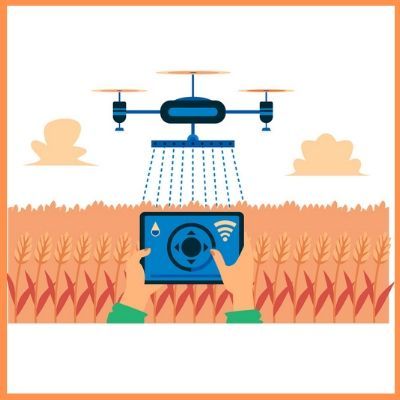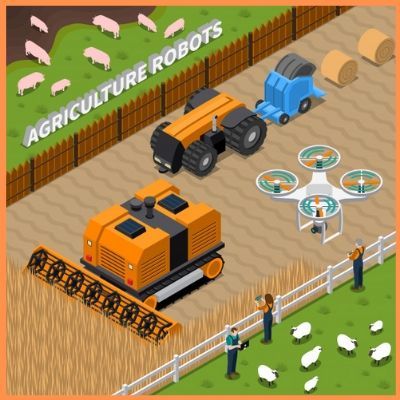
The collaboration of agriculture with technology might be the most revolutionary one that’s ever been. Agriculture is an industry that accounts for a major portion of a country's growth and economic stability. The evolution of the agricultural industry from a basic occupation to a full-fledged high-tech industry has altered the parameters of development and the standards keep on rising. Let us read a complete study on Robotic Farming and Its Impact.
Need of Robotics in the Farming Industry
History of Robotics Industry
Demand in The Market
What All Can Robots Do?
Role of Robots While Farming
Agricultural Robotics Companies in India
Benefits of Doing Robotic Farming
FAQ's
Conclusion
Need of Robotics in the Farming Industry
The world is growing at a supersonic speed and predictions say that a number as high as 9 billion would represent the human population by 2050. To cater to a world so big, a striking growth in agricultural production is required. This might justify why farmers’ are taking assistance from the robotic world. This gives a hint about Robotic Farming and Its Impact.
Customer service, manufacturing, mining, packaging, and shipping, manufacturing, and transportation are all industries that are already using robots to increase their outputs and aim to double the involvement.
The boom in the artificial intelligence (AI) sector, the rising population, and the invention of more and more utilitarian robots have caused agriculture to open its gates to innovation. The Verified Market Research, says that the agricultural robots market is expected to touch $11.58 billion by 2025, becoming one of the well-invested markets in the upcoming decade.
History of Robotics Industry

The first vision of robotics was visible in the agriculture scenario, which can be traced back to the 1920s while doing research-related work i.e. use of automatic vehicle guidance. This landed the advancements between the 1950s and 60s of automated agricultural vehicles. Other developments in this field over the years include the harvesting of oranges using a robot both in France and the US.
The indoor industrial settings had used robots for decades, outdoor robots for the use of agriculture are considered a little more complicated and difficult to furnish. Concerns over safety, over the complexity of picking crops subject to different environmental factors and unpredictability, make the process a little more demanding.
Demand in The Market
There is a looming fear related to the dearth of labor and increasing demands. With a majority population of aging manpower, countries like Japan are failing to meet the labor market's clamor. Similarly, in the US, the sector mainly depends on 0n immigrant workers, but the decline in seasonal farmworkers and the country’s notion to stop immigration makes it difficult to meet the bars.

What All Can Robots Do?

Agricultural robots usually come in handy to perform tasks that are slow, repetitive, and dull for farmers, automating these helps the farmers on focusing more on improving the overall yield. The common duties that robots can perform are:
- Harvesting and picking.
- Automated mowing, pruning, seeding, spraying.
- Weed Control.
- Sorting and packing.
- Phenotyping.
- Environmental Monitoring.
- Soil analysis.
Caring and harvesting crops are some of the most common activities for which many robotic farming companies are developing robots. For instance, Fendt’s Xaver robot, expected to hit the market this year, can execute tasks such as planting and fertilizing crops like corn, weed control, and scouting operations.
Vision Robotics from San Diego is working on robots that will perform “thinning,” that ensures that seeds have sufficient space apart during planting, fastening their growth.
Role of Robots While Farming
Robots have also played a crucial role in preventing losses as big as $43 billion due to weeds resistant to herbicides are also set to help farmers by preventing some of the $43 billion losses created by herbicide-resistant weeds. Later, many robotic farming companies like Blue River Technology has introduced a See & Spray robot in the market and marketed it as an effective weed-spraying machine.
Monitoring huge fields of the crop is a humongous task. New sensor and geo-mapping technologies allow farmers to get a much advanced level of data about their crops than they had before. Drones and ground robots provide a way to collect this data autonomously.
Another example, in this case, is the TerraSentia robot which was developed by EarthSense which can autonomously move through the fields and uses sensors to monitor various plant parameters to analyze the crops without any need for men's power. It can also be further developed to detect common plant ailments. The data will progressively help scientists to understand the optimal environment to nurture the best crops.

Benefits of Doing Robotic Farming
Irrigating and fertilizing crops is one of the key steps in nurturing healthy crops, evidently, this uses excess water decreasing efficiency. Inventions like Robot-Assisted Precision Irrigation can help in reducing wasted water by targeting specific plants. Ground robots autonomously navigate through the rows of crops and pour water directly at the base of each plant.
Robots have an additional ability to access areas where other machines cannot. Robotic advancements will also help in filling the decreasing manpower in the agriculture sector. Robots that are being developed have a workload capacity equivalent to 30 human workers.
This will allow the farmers to focus more on the entrepreneurial aspects rather than the manual work involved. These will lead to labor and time savings, an increase in crop yield proving that technological progress is pervading all aspects of our lives. It will empower the farmers to spend a little less time in the business and more time on the business.
Agricultural Robotics Companies in India
- Blue River Technology.
- Harvest CROO Robotics.
- PEAT.
- Trace Genomics.
- SkySquirrel Technologies Inc.
- aWhere.
- FarmShots.
- Abundant Robotics.

FAQ's
What is the future of robotics in agriculture?
Use of Agricultural Robots Will Lead to Skilled Jobs. It just means that the new generation of farmworkers will need more advanced skills to work alongside robots. Today's farmworkers will become tomorrow's fleet managers who oversee robotic farming systems and autonomous vehicles.
Which farming is profitable in India?
Tree Farming- From tree farms, you can earn profits by growing and selling trees. In this business, it takes a long time till the trees grow, due to which the business and its profit will also take time. But it comes under the category of good and profitable agriculture business.
Is robotics the future of cattle farming?
According to many researchers, the agricultural robot market should have an annual growth rate of over 20% until 2022. Today, a vast majority of robotics on farms are for milking cows or indoor machines. But soon, robots will start working outdoors in the future.
How can robots be used in agriculture?
Agricultural Robot Applications- Some of the most common robots in agriculture are used for harvesting and picking. Weed control. Autonomous mowing, pruning, seeding, spraying, and thinning.
What are some agricultural robots?
Some of the robots in agriculture.
- Ecorobotix.
- Naio Technologies.
- Energid Citrus Picking System.
- Agrobot E-Series.
- Blue River LettuceBot2.
- Agribotix.
- Vision Robotics.
- RoBoPlant.
How AI can help agriculture?
AI-enabled agriculture bots help farmers to find more efficient ways to protect their crops from weeds. AI bots in the agriculture field can harvest crops at a higher volume and faster pace than human laborers. By leveraging computer vision helps to monitor the weed and spray them.
What are agricultural robots?
Agricultural robots automate slow, repetitive, and dull tasks for farmers, allowing them to focus more on improving overall production yields. Some of the most common robots in agriculture are used for: Harvesting and picking. Weed control. Autonomous mowing, pruning, seeding, spraying, and thinning.
Conclusion
Though the potential of these machines is extraordinary, they inevitably lead us to the archaic fear that robots will replace human manpower. The positive outlook can be that the farmworkers can function as the operators and managers supervising these automata. The demand for food is surpassing available land for growing crops and only farmers can fill the gap. Involving robotic power to the sector will not only enhance the agricultural process but will help in increasing the outputs manifold. We are still in beginner levels of the age of the robotics revolution with most of the inventions in the early trial phases and the R&D phase. These Agribots can create a massive altercation and prove that the future will witness an overpowering reliance on AI, steered by humans.
Author: Yash Gupta
Source : https://startuptalky.com/robotic-farming/
Date : 2021-05-06T11:30:00.000Z

